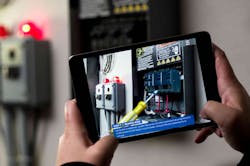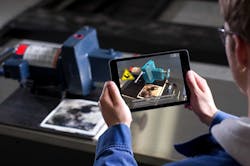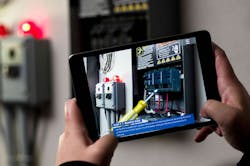Augmented reality (AR) can be used for myriad applications, ranging from games like Pokémon Go to tools like Scope AR’s WorkLink (Fig. 1). WorkLink is an AR application that can work with devices as varied as AR glasses, smartphones, and tablets. It uses a device's camera to help identify objects within view and provides audio and video feedback. AR glasses provide a hands-free mode of operation, while smartphones and tablets are more readily available.
The system is quite impressive because it identifies objects without the need for 3D imaging systems like Intel's RealSense cameras. This is possible through some complex software as well as not needing the 3D resolution provided by 3D cameras, although they could be useful in the future. Conventional high-res cameras tend to be readily available on AR glasses, smartphones, and tablets.
In addition, the system needs the positioning and movement sensors normally found on these devices. This allows for the orientation and position of the viewing device to be tracked, as well. The AR added information is then merged using all this position and orientation information so the user can view an AR world through the device's display. For AR glasses, the system only needs to display the AR material since the real world view is already available to the user.
WorkLink can be used for many applications, from training to service support. It could also be used for instructions or procedures for customers.
The system can be linked to a knowledge database that users can interact with providing additional input via the AR camera. WorkLink can then inject 3D models, images, video, animations and text (Fig. 2) to provide feedback to the user. The system can also be used to create scenarios that present augment reality information on the user’s display.
The system can also be used to collect data while it is in use. For example, the GPS location may be useful in identifying the device being examined or worked on. The time taken per step within a training or repair session can be useful, as well. The application creator can include items such as checklists, safety checkpoints, and sign-offs to streamline the process.
The Remote AR tool combines remote collaboration with WorkLink's AR functionality. Remote AR takes advantage of the system's ability to maintain a logical position for AR-added material like a 3D model so the user can move but still view the model that is normally overlaid on a physical object. With Remote AR, a remote user such as a technician or expert can add persistent annotations such as text or bubbles or images while communicating with the AR user.
Remote AR has a low-bandwidth mode where snapshots are sent instead of live video. This is handy when the connection may have limitations due to distance or cell coverage. The annotations can still be sent and the user’s system will keep track of where and how they are displayed.
The AR features of WorkLink and Remote AR are quite impressive and highlight what AR is capable of. Creating scenarios and building a database is not a trivial task, but it is quite manageable using Scope AR’s tools.
At this point, Scope AR's software supports AR glasses from ODG and Epson with support for Microsoft Hololens and Meta's Meta 2 coming soon. It works with Apple and Android tablets. Windows support is also in the works. The desktop application runs on Windows.
Scope AR has done an impressive job in creating a useful and easy-to-use system. It is difficult to handle the basic AR support where the system identifies and tracks the user’s environment, so logically placed items remain fixed with respect to the world allowing the user to view information from different perspectives. The rest of the system is equally impressive since there can be a massive amount of information to be presented based upon the visual context of the user, as well as the interaction of the user—and possibly remote users.
About the Author
William G. Wong
Senior Content Director - Electronic Design and Microwaves & RF
I am Editor of Electronic Design focusing on embedded, software, and systems. As Senior Content Director, I also manage Microwaves & RF and I work with a great team of editors to provide engineers, programmers, developers and technical managers with interesting and useful articles and videos on a regular basis. Check out our free newsletters to see the latest content.
You can send press releases for new products for possible coverage on the website. I am also interested in receiving contributed articles for publishing on our website. Use our template and send to me along with a signed release form.
Check out my blog, AltEmbedded on Electronic Design, as well as his latest articles on this site that are listed below.
You can visit my social media via these links:
- AltEmbedded on Electronic Design
- Bill Wong on Facebook
- @AltEmbedded on Twitter
- Bill Wong on LinkedIn
I earned a Bachelor of Electrical Engineering at the Georgia Institute of Technology and a Masters in Computer Science from Rutgers University. I still do a bit of programming using everything from C and C++ to Rust and Ada/SPARK. I do a bit of PHP programming for Drupal websites. I have posted a few Drupal modules.
I still get a hand on software and electronic hardware. Some of this can be found on our Kit Close-Up video series. You can also see me on many of our TechXchange Talk videos. I am interested in a range of projects from robotics to artificial intelligence.




